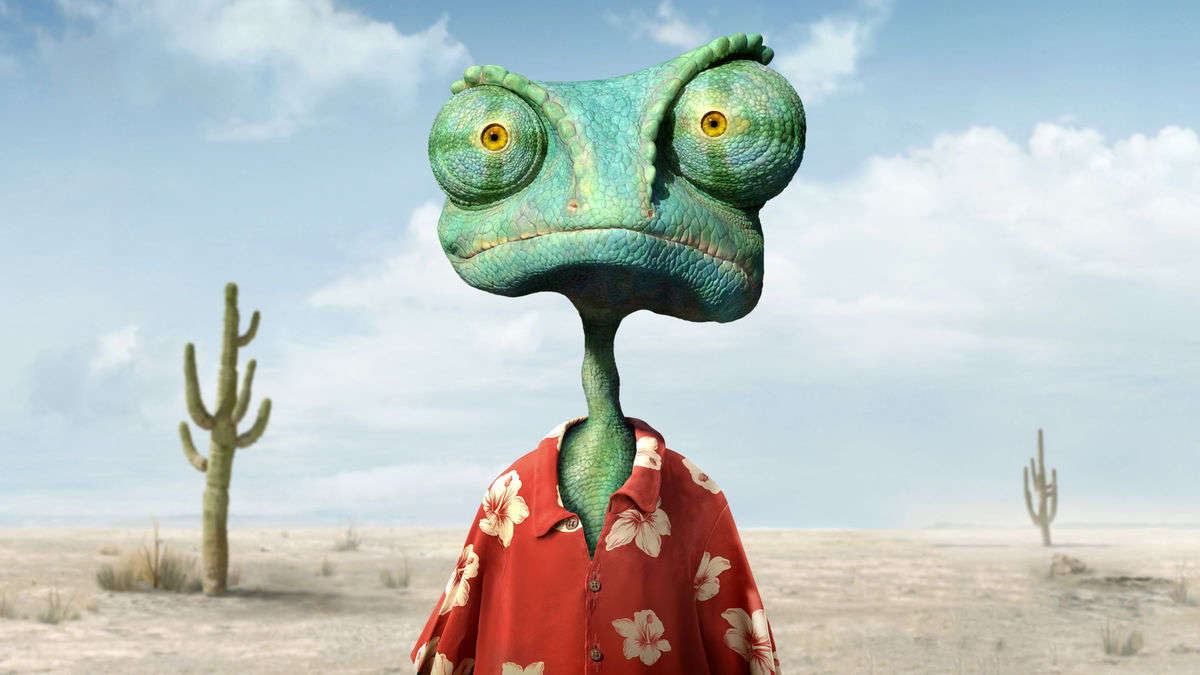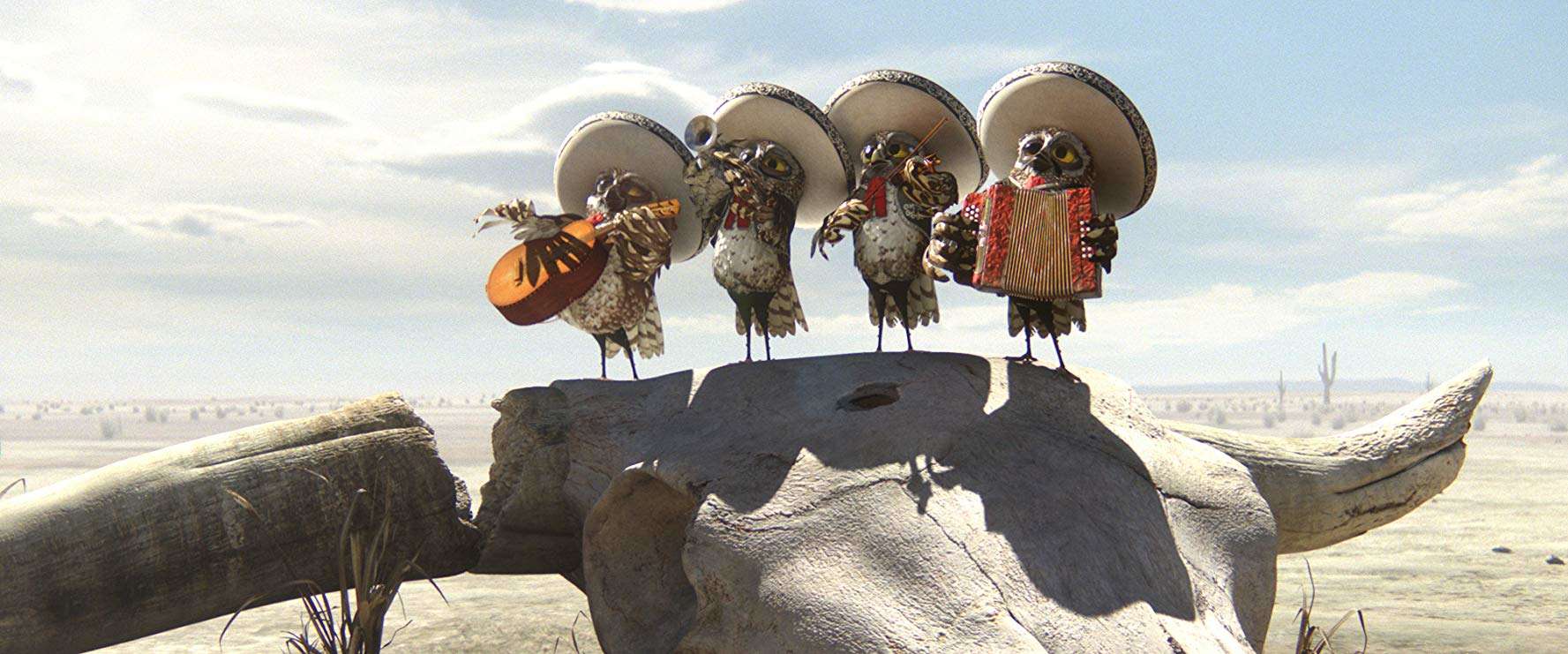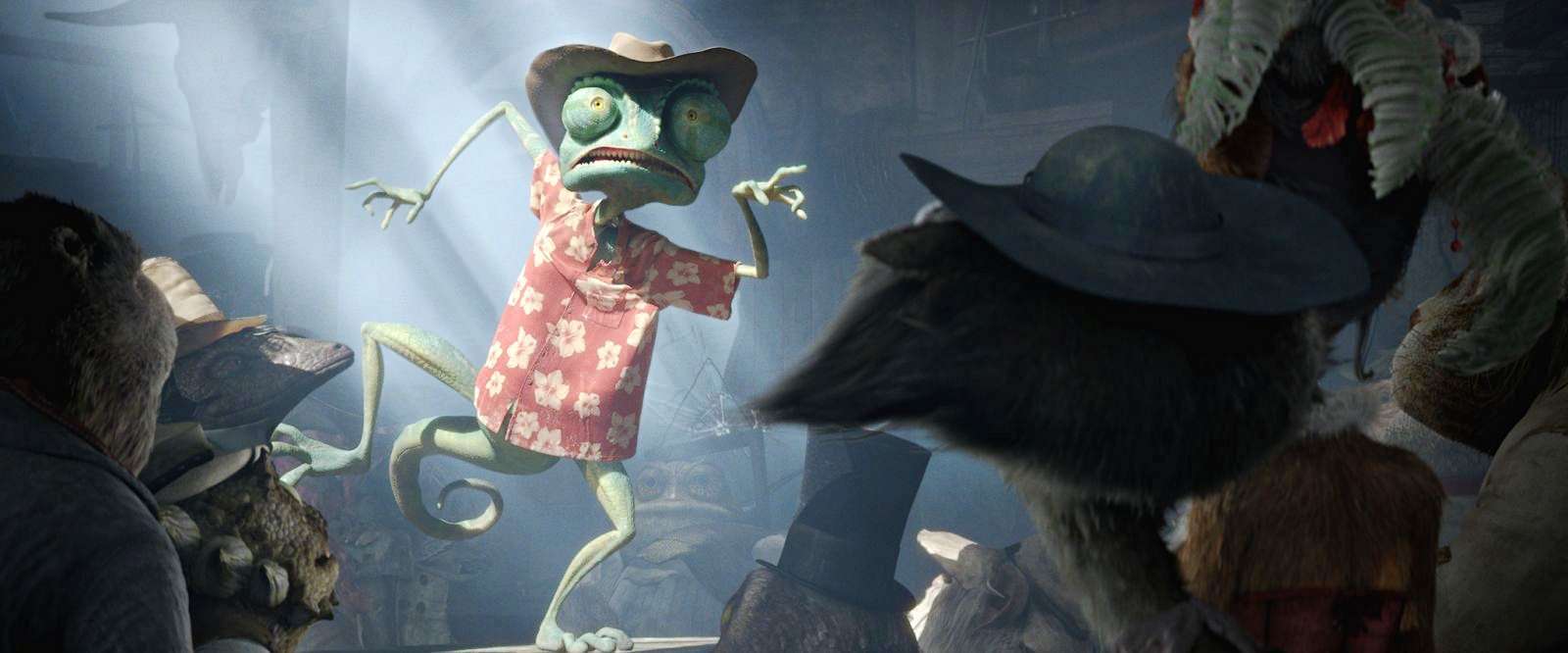Create a free profile to get unlimited access to exclusive videos, sweepstakes, and more!
'Symmetry is not our friend': How Rango, one of Hollywood's most out-of-the-box animations, got made

There was nothing in cinemas that looked like Rango when it released a decade ago this month. Director Gore Verbinski’s first animated feature successfully parodied and paid homage to the Western genre — both the Hollywood classics directed by John Ford and Fred Zinneman, as well as the spaghetti Westerns made famous by Italian director Sergio Leone — and wrapped it all together in a story straight out of a New Hollywood neo-noir. Despite having a roster of A-listers providing their voices (Johnny Depp, Isla Fisher, Timothy Olyphant, Alfred Molina), what truly made Rango unique among all of the other animated films at the time was the film’s unique visual style, especially when it came to the film's star and his supporting cast.
Rango (Depp), a chameleon who discovers himself while saving the lawless town of Dirt, and the other anthropomorphic desert animals featured were wholly unlike the cute and easily marketable creatures found in other 3D animated films released that year, such as Puss in Boots and Kung-Fu Panda 2. Early in the film, we watch as Rango, a stranger in a strange new town, not yet adopting his new name and identity, passes by creatures who have certainly seen better days. There's Doc (Stephen Root), a jackrabbit with shaggy fur and his right ear missing; there's also Sergeant Turley (Verbinski), a wild turkey with an arrow impaled through his skull. Even Rango himself, with his crooked neck, pot-bellied physique, and disproportionate eyes, is not something audiences would expect from an animated cartoon attached to Nickelodeon Movies.
Verbinski, who had just come off directing the first three Pirates of the Caribbean films — successfully turning a decades-old Walt Disney theme park ride into one of the biggest franchises in Hollywood — did not want to direct just another animated feature. More importantly, he didn’t want to make it in a traditional way.
“SYMMETRY IS NOT OUR FRIEND”
After acquiring some funding from producer Graham King to make a showreel, Verbinski set up shop at his old home in Pasadena where he would spend the next 18 months working, shaping, and crafting Rango into the film we see today. He brought in screenwriter John Logan (Gladiator, The Aviator), line producer and sculptor Adam Cramer (Lee), and four artists who would be responsible for giving the film’s animated stars their unique look: Eugene Yelchin (Rome), David Shannon (Recess), Mark “Crash” McCreery (Terminator 2: Judgement Day, Jurassic Park), and James Ward Byrkit (Mouse Hunt, Pirates of the Caribbean).
Verbinski had known all four artists for years, either during his time directing Hollywood features or in his early years working behind the camera on commercials and music videos. The idea of assembling a collection of creatives to work freely, away from the gaze of a Hollywood studio, was, according to Byrkit — who had worked with Verbinski on his debut Mouse Hunt and all three Pirates films — in the works for some time. “He told me by the end of Pirates 3 that he was dreaming of a plan to escape with a handful of artists and creating a whole world on our own,” Byrkt told SYFY WIRE over email.
The plan from day one was to approach the movie more like a live-action film and to make all of the characters look unusual and distinct. Shannon, a children's book author and illustrator who was in the room with Verbinski and producer John B. Carls in 2003 when the idea for what would become Rango was first mentioned, shared over Zoom an early motto the director and everyone in the house followed: “Symmetry is not our friend.”
Shannon, unlike everyone else brought in (including Verbinski), was the only person with any experience working in feature animation, having done character designs for Disney on Recess: School’s Out. McCreery, who had the most Hollywood experience didn’t hesitate to work with Verbinski on this new venture.
“Anything he’s a part of, I want to be part of it,” McCreery says. However, working on Rango did place him in a world he had always been hesitant to join: “I know my niche, I know what I'm good at, and I have such a deep respect for animation because it's a whole other discipline. I think that's why I've avoided it for so long.”
Early on, McCreery didn’t think he could make the transition. “The first designs I started on, I was trying to act and design like an animation guy, and they were just horrible,” he remembers. “There was definitely a point where I was going, ‘I don't know if I can do this.’”
Byrkit also recalls those early days of frustrations. “There was an unspoken expectation at first to simplify designs and make our characters more like Pixar, which was so different than our natural instincts,” he says.
The discouragement did not last long. After a conversation between the two, they decided to stop attempting to match Pixar and DreamWorks Animation and draw how they felt the characters should look. “Once we committed to that, everything broke open,” Byrkit says.
Ultimately, Shannon explains, it was McCreery who took everyone’s illustrations and “crashified” them into his own style. “His level of detail is unbelievable,” Shannon enthuses. “He really gave the movie a cohesive look.”
PUTTING THEM IN THE SPIRIT
For inspiration, Verbinski compiled a list of Westerns for the artists to watch before production: a list consisting of classic Hollywood and Spaghetti Westerns, plus a handful of films starring the comedian Don Knotts such as The Shakiest Gun in the West, and a personal favorite of Shannon’s, the horror-comedy The Ghost and Mr. Chicken. Yelchin, who first met Verbinski at a dive bar off Hollywood Boulevard sometime in the 1990s and did the storyboards for all of the commercials Verbinski directed in his early years behind the camera, told us over Zoom that the repeated showing of those classic and oddball films greatly benefited the artistic process, explaining that it put them “in the spirit.”
Yelchin, an author, illustrator, painter, and former theater designer in his native Russia, initially turned down the chance to work with Verbinski on Pirates because he was attempting to fulfill his own directorial ambitions. “Like every other fool who comes here [Los Angeles], I wanted to be the big Hollywood director,” he says. “The problem with my ideas was that they were absolutely not American Hollywood ideas. I grew up on Russian art cinema and it was kind of difficult to translate it into what was popular at the time.”
When Verbinski approached Yelchin for Rango, giving him the same one-line pitch he delivered to all the artists — “An animated film featuring desert animals” — Yelchin didn’t hesitate. It was a chance to finally work alongside his good friend, the experience turning out to be one of those moments where life comes full circle. When he was a young boy living in Soviet Russia, he was enchanted by the classic John Sturges Western The Magnificent Seven. That experience led him to want to learn more about American culture and eventually move to the United States. “Westerns is what brought me to the U.S. and for Gore to make a Western, it was a dream,” he recalls. “So I instantly said ‘yes.’”
All of the artists stress that the creative process was extremely collaborative, with each of them learning, critiquing, and stealing from one another. Each creator contributed to the look of each creature
However, during our conversations with them, we learned of some personal touches they added. Shannon based his drawings of Rango on the pet he had when he was younger, an American Lizard named Deacon; the plastic beach enclosed in a glass case where we first meet Rango looks exactly like the one he kept Deacon in. Byrkit tells us that he drew the first definitive version of Rango, gaining inspiration after visiting a pet shop with Verbinski and Adam Cramer.
“I was absolutely struck by how his eyes were soulful and full of life, turning independently from one another,” Byrkit recalls “This guy reminded me so much of Don Knotts, and there also seemed to be a Fear and Loathing In Las Vegas aspect happening, so it all came together for me.” Byrkit refers to Rango as “a freaky exaggerated version of my own physicality,” with a resemblance so strong that he was embarrassed seeing the advertising posters because of how much he saw himself in the character.
It wasn’t all work inside Verbinski’s home, of course. On Fridays, it wasn’t unusual for Verbinski and his artistic posse to kick back with some barbecue, eating hotdogs while drinking expensive wine. They’d watch the sunset going over the Pasadena hills or, as Byrkit describes it, get into some “intense foosball games.” Impromptu jam sessions would see Verbinski and his artists playing guitar, drums, and other rhythm instruments.
“That was a magical time,” Byrkit, who went on to direct the 2013 film Coherence, says. “Luckily, even at the time I was aware how special and rare it was so I appreciated every minute.”
KEEPING AN OUTLAW MENTALITY
The kind of environment that Verbinski cultivated in his home, that always-present outlaw mentality, was only possible if the artists truly felt free to work and experiment with their designs. Freedom was an aspect all the artists echoed when speaking of their experiences in the house.
“We were conscious of not letting the rules affect us, we just wanted to do some cool,” Shannon says.
“I had no restrictions on Rango,” Yelchin says. “With advertising, all you do is face restrictions; with Gore, it was ‘Let's make them look ugly and scary and real.’ That was very different and to me, a lot more satisfying.”
When the artists saw the finished product after Industrial Light and Magic (Rango being the iconic production house’s first animated feature) took their illustrations and gave them life, they were all impressed by how close their work resembled the finished product.
“I was really blown away by the way it looked,” Yelchin says, “I couldn't even follow the story. I was so overwhelmed by the visuals.”
In his glowing, four-star review of the film, Roger Ebert wrote: “The characters are wildly exaggerated, yes, but with an underlay of detail and loving care.” For The New York Times, critic A.O. Scott praised the film referring to its style as “entirely unlike the plasticized landscapes of most animation.” As for the creatures, he wrote, they “are arrestingly, grotesquely hairy, slimy and scaly.” Rango opened at a respectable $38 million dollars, ending up with a domestic total of $123 million, placing it as the 22nd highest-grossing film of the year domestically.
Rango became only the third non-Disney affiliated animated film to earn the Academy Award for Best Animated Feature in 2012, and perhaps more importantly for the artists, it won the Annie Award for Best Character Design. A decade later, the artists, who have gone to write and illustrate books, work in Hollywood, and even go into teaching, all recognized that they were a part of something unique — not only in Hollywood but in animation as a whole.
“I've had good experiences and some terrible experiences working in the movie business,” Shannon says. “But by far the best experience I've had was working with Gore because it was fun.”
Yelchin was glad to once again work with his good friend, and to be able to work alongside people he quickly grew to admire, recalling the “extraordinary talents that he [Verbinski] had brought together. I’m lucky, just plain lucky.”
Rango is one of the rare 3D animated features that could be released today and still stand out among all of the other animated films made by Pixar, Disney, DreamWorks, and the newest member of the feature animation field, Netflix. A major part of the timeliness the film still possesses is due to the incredibly unique and talented roster Verbinski gathered in his home, a band of creatives who took a simple concept — a Western with desert animals — and helped turn it into one of the most unique American animated films of the past 20 years.
On March 6, two days before Rango's 10th anniversary, Verbinski announced that he was making not one, but two new animated features, one of them a musical, and that he will once again collaborate with cinematographer Roger Deakins, who worked as a consultant on Rango. It will be wonderful to see Verbinski bring his unique sensibilities back to animation someday soon, hopefully, he will be bringing his friends along with him.




























